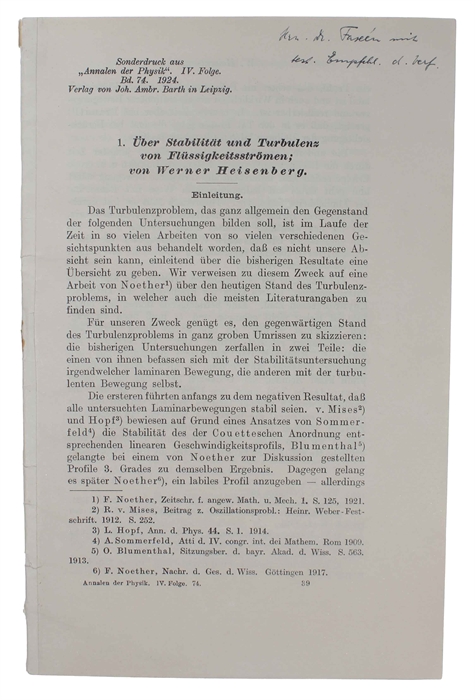OFFPRINT PRESENTATION COPY OF HEISENBERG'S DISSERTATION
HEISENBERG, WERNER.
Über Stabilität und Turbulenz von Flüssigkeitsströmen.
(Leipzig, Johann Ambrosius Barth), 1924.
8vo. Offprint from "Annalen der Physik" IV. Folge, Bd. 74, 1924. With the author's presentation inscription to upper right corner of first leaf: "Hrn. Dr. Faxeén mit / best. Empfehl. d. verf.". Stapled spine with rust slightly affecting surrounding paper. A very fine and clean copy. Pp. (1), 578-627.
First edition in the exceedingly rare offprint - with a most attractive presentation-inscription from Heisenberg to Swedish Hilding Faxén, an important contributor to the field - of Heisenberg's doctoral dissertation on the stability and turbulence of fluid flow, which "involved an approximate solution of the complicated equations governing the onset of hydrodynamic turbulence"(David C. Cassidy). It is widely regarded as being "the most important early paper devoted to this subject". (Yaglom, Hydrodynamics Instability and Transition to Turbulence).
Hilding Faxén (1892 - 1970), Swedish physicist, received his doctorate in 1921 at Uppsala University with his thesis on "the influence of the container walls on the resistance against movement by a small ball in a viscous fluid". He formulated several basic equations mainly in hydrodynamics; the Faxén integral, the Faxén laws, the Faxén theorems and the Faxén-Waller theory.
Heisenberg and Faxén most likely met at the Institute of Theoretical Physics at the University of Copenhagen (Directed by Niels Bohr) where Heisenberg, From 17 September 1924 to 1 May 1925, studied under an International Education Board Rockefeller Foundation fellowship.
Despite Sommerfeld's positive evaluation of Heisenberg's thesis - "In the handling of the present problem, Heisenberg shows once again his extraordinary abilities: complete command of the mathematical apparatus and daring physical insight" (Arnold Sommerfeld, evaluation of the thesis, 1923) -, the oral presentation did not go as Heisenberg could have hoped for:
"Acceptance of the dissertation brought admission of the candidate to the final orals, where in this case trouble began. The examining committee consisted of Sommerfeld and Wien, along with representatives in Heisenberg's two minor subjects, mathematics and astronomy. Much was at stake, for the only grades a candidate received were those based on the dissertation and final oral: one grade for each subject and one for overall performance. The grades ranged from I (equivalent to an A) to V (an F).
As the 21-year-old Heisenberg appeared before the four professors on July 23, 1923, he easily handled Sommerfeld's questions and those in mathematics, but he began to stumble on astronomy and fell flat on his face on experimental physics. In his laboratory work Heisenberg had to use a Fabry-Perot interferometer, a device for observing the interference of light waves, on which Wien had lectured extensively. But Heisenberg had no idea how to derive the resolving power of the interferometer nor, to Wien's surprise, could he derive the resolving power of such common instruments as the telescope and the microscope. When an angry Wien asked how a storage battery works, the candidate was still lost. Wien saw no reason to pass the young man, no matter how brilliant he was in other fields." (Cassidy, Uncertainty).
The result was that Heisenberg received the lowest of three passing grades in physics and the same overall grade (cum laude) for his doctorate, both of which were an average between Sommerfeld's highest grade and Wien's lowest grade.
There is an interesting epilogue to the story. When Heisenberg derived the uncertainty relations several years later, he used the resolving power of the microscope to derive the uncertainty relations - and he still had difficulty with it. When Bohr pointed out the error, it led to emotional difficulties for Heisenberg. Likewise, this time a positive result came off the affair: Heisenberg's reaction induced Bohr to formulate his own views on the subject, which ultimately led to the so-called Copenhagen Interpretation of quantum mechanics.
Heisenberg was awarded the Nobel Prize in Physics in 1932 "for the creation of quantum mechanics, the application of which has, inter alia, led to the discovery of the allotropic forms of hydrogen".
Faxén was appointed professor of mechanics at the Royal Institute of Technology in Stockholm, where he remained until his retirement in 1958. In 1948 he was elected a member of the Royal Swedish Academy of Sciences.
Cassidy 1924b.
Order-nr.: 53190

